In the second half of the 19th century, the Mexican government partnered with British companies to built the railway line that would connect Mexico City with the Atlantic Ocean. This iconic railway infrastructure now lies in ruins, much of it abandoned due to the privatisation of the railway system in 1995, when it was decided that transporting people was simply not profitable enough. Many passenger train lines were thus cut off, the infrastructure was left to rot and communities became geographically and economically isolated as a consequence.
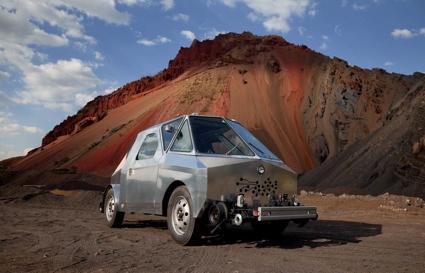 Ivan Puig and Andrés Padilla Domene, SEFT-1 in front of the volcano Yuhualixqui in the exhibition SEFT-1 Abandoned Railways Exploration Probe – Modern Ruins 1:220 presented by The Arts Catalyst and Furtherfield, London June 2014
Ivan Puig and Andrés Padilla Domene, SEFT-1 in front of the volcano Yuhualixqui in the exhibition SEFT-1 Abandoned Railways Exploration Probe – Modern Ruins 1:220 presented by The Arts Catalyst and Furtherfield, London June 2014
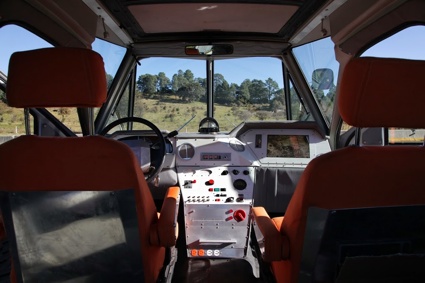 Ivan Puig and Andrés Padilla Domene, SEFT-1 interior of cabin in the exhibition SEFT-1 Abandoned Railways Exploration Probe – Modern Ruins 1:220 presented by The Arts Catalyst and Furtherfield, London June 2014
Ivan Puig and Andrés Padilla Domene, SEFT-1 interior of cabin in the exhibition SEFT-1 Abandoned Railways Exploration Probe – Modern Ruins 1:220 presented by The Arts Catalyst and Furtherfield, London June 2014
Ivan Puig and Andrés Padilla Domene, aka Los Ferronautas (from ferrocarriles which means railway in spanish), wanted to travel along the ruins of the passenger railway system and investigate the remains of what they consider a misuse of common resources and therefore a political issue.
But to drive around the rusty lines, they needed to build their own light vehicle. The result is a half car half spaceship hybrid called SEFT-1 (the Sonda de Exploración Ferroviaria Tripulada, in english Manned Railway Exploration Probe). But SEFT-1 is much more than a vehicle. Los Ferronautas call it a research tool because it allows them to investigate notions and promises of progress. The vehicle is also a transmitter of non-eletronic stories, it enabled the duo to visit and interview communities which the privatization of the railway has been left behind.
As they traveled through the country in 2010 and 2011, the artists shared their discoveries online, mapping their trajectory, archiving objects found by the tracks, writing down anecdotes, uploading photos and interviews with the people they met along the way.
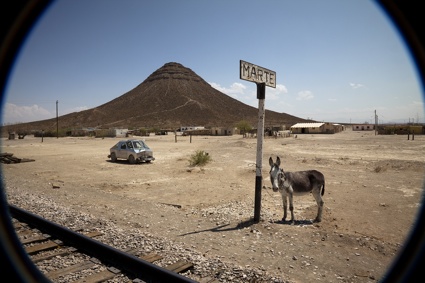 Marte (Mars in english) is a half-abandoned village in Oaxaca, in the south east of México
Marte (Mars in english) is a half-abandoned village in Oaxaca, in the south east of México
I’ve been following the work of Los Ferronautas ever since i read an article about them in the always excellent blog Arte en la Edad del Silicio so i’m really happy that they finally have their first London exhibition, SEFT-1 Abandoned Railways Exploration Probe: Modern Ruins 1:220, thanks to The Arts Catalyst and Furtherfield Gallery.
The show opens tomorrow 20 June between 6 and 8pm and there’s a tour of the exhibition with the artist on Saturday. The vehicle will be on show of course but there will be more:
For this new exhibition, the artists are inviting British expert model railway constructors to collaborate by creating scale reproductions of specific Mexican railway ruins, originally built by British companies, exactly as they are now. One gallery becomes a space for the process of model ruin construction. The room’s walls will show the pictures, documents, plans and other materials used as reference for the meticulously elaborated ruin construction. With this action a dystopian time tunnel is created.
I’m really looking forward to discovering what Los Ferronautas will do in collaboration with the model makers. Already, they have reproduced in photo and using their own vehicle a scene painted by José María Velasco in 1881. During a presentation they gave on Saturday at a London LASER04 session, they announced that the whole landscape would be recreated by British model enthusiasts.
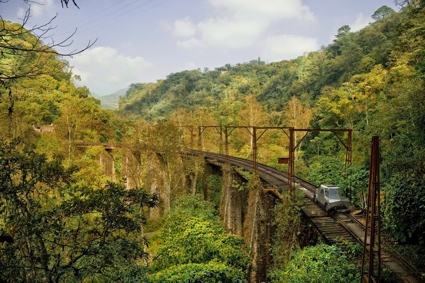 Ivan Puig and Andrés Padilla Domene, SEFT-1 over metal bridge in the exhibition SEFT-1 Abandoned Railways Exploration Probe – Modern Ruins 1:220 presented by The Arts Catalyst and Furtherfield, London June 2014
Ivan Puig and Andrés Padilla Domene, SEFT-1 over metal bridge in the exhibition SEFT-1 Abandoned Railways Exploration Probe – Modern Ruins 1:220 presented by The Arts Catalyst and Furtherfield, London June 2014
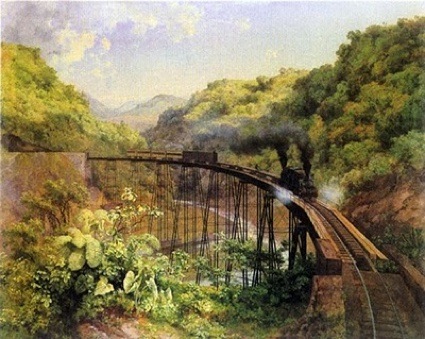 José María Velasco, Bridge at Metlac, 1881
José María Velasco, Bridge at Metlac, 1881
SEFT-1 Abandoned Railways Exploration Probe
More photos:
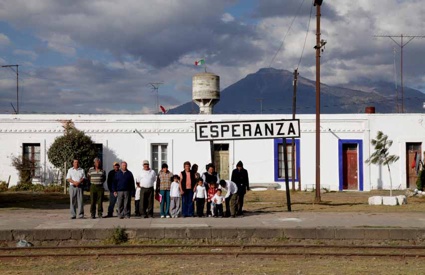 Esperanza station in Puebla, was created thanks to train traffic. Its population reached up to 19000 inhabitants in its heyday. The town is now looking for ways to survive
Esperanza station in Puebla, was created thanks to train traffic. Its population reached up to 19000 inhabitants in its heyday. The town is now looking for ways to survive
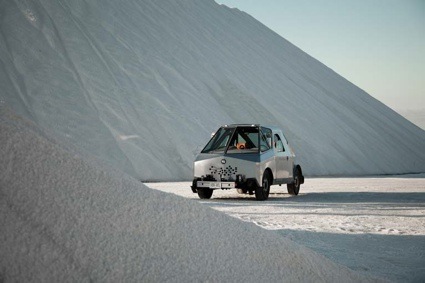 This lunar landscape is in fact set in the salt mine of Las Coloradas, Yucatán, in the south east of México
This lunar landscape is in fact set in the salt mine of Las Coloradas, Yucatán, in the south east of México
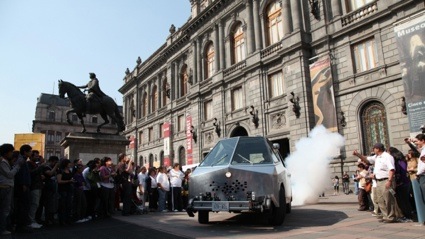 Los ferronautas started they journey on 20 November 2010 in front of the Museo Nacional de Arte, in Mexico City
Los ferronautas started they journey on 20 November 2010 in front of the Museo Nacional de Arte, in Mexico City
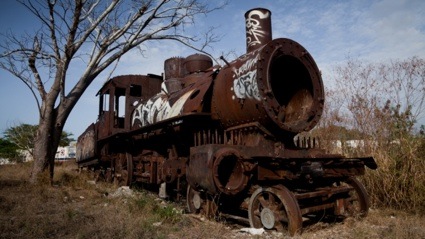 A Baldwin locomotive from 1925 (image Los Ferronautas)
A Baldwin locomotive from 1925 (image Los Ferronautas)
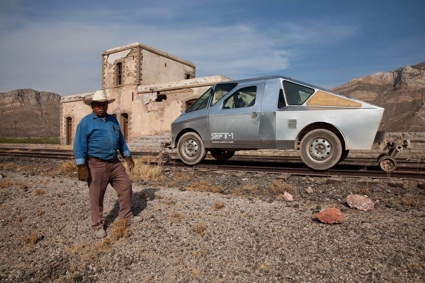 Ivan Puig and Andrés Padilla Domene, SEFT-1 in La Loma station, Durango in the exhibition SEFT-1 Abandoned Railways Exploration Probe – Modern Ruins 1:220 presented by The Arts Catalyst and Furtherfield, London June 2014
Ivan Puig and Andrés Padilla Domene, SEFT-1 in La Loma station, Durango in the exhibition SEFT-1 Abandoned Railways Exploration Probe – Modern Ruins 1:220 presented by The Arts Catalyst and Furtherfield, London June 2014
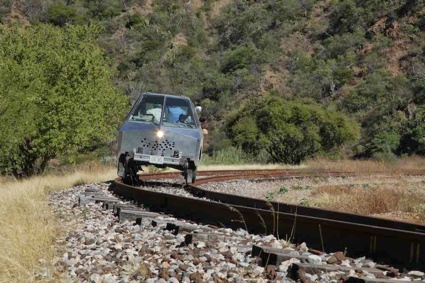 Ivan Puig and Andrés Padilla Domene, SEFT-1 in Telixtlahuaca in the exhibition SEFT-1 Abandoned Railways Exploration Probe – Modern Ruins 1:220 presented by The Arts Catalyst and Furtherfield, London June 2014
Ivan Puig and Andrés Padilla Domene, SEFT-1 in Telixtlahuaca in the exhibition SEFT-1 Abandoned Railways Exploration Probe – Modern Ruins 1:220 presented by The Arts Catalyst and Furtherfield, London June 2014
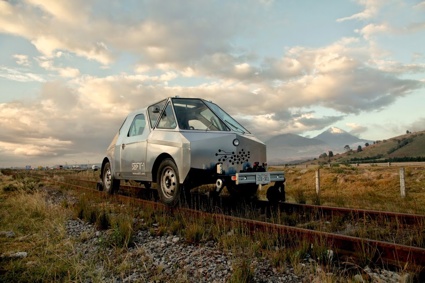 van Puig and Andrés Padilla Domene, SEFT-1 with Citlaltépetl in the background No. 2 in the exhibition SEFT-1 Abandoned Railways Exploration Probe – Modern Ruins 1:220 presented by The Arts Catalyst and Furtherfield, London June 2014
van Puig and Andrés Padilla Domene, SEFT-1 with Citlaltépetl in the background No. 2 in the exhibition SEFT-1 Abandoned Railways Exploration Probe – Modern Ruins 1:220 presented by The Arts Catalyst and Furtherfield, London June 2014
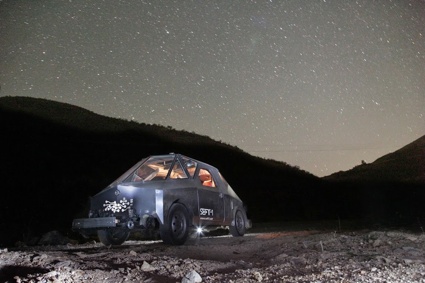 Ivan Puig and Andrés Padilla Domene SEFT-1 under the stars of Taviche in the exhibition SEFT-1 Abandoned Railways Exploration Probe – Modern Ruins 1:220 presented by The Arts Catalyst and Furtherfield, London June 2014
Ivan Puig and Andrés Padilla Domene SEFT-1 under the stars of Taviche in the exhibition SEFT-1 Abandoned Railways Exploration Probe – Modern Ruins 1:220 presented by The Arts Catalyst and Furtherfield, London June 2014
SEFT-1 Abandoned Railways Exploration Probe: Modern Ruins 1:220 is at Furtherfield in Finsbury Park from 20 June until 27 July 2014.
